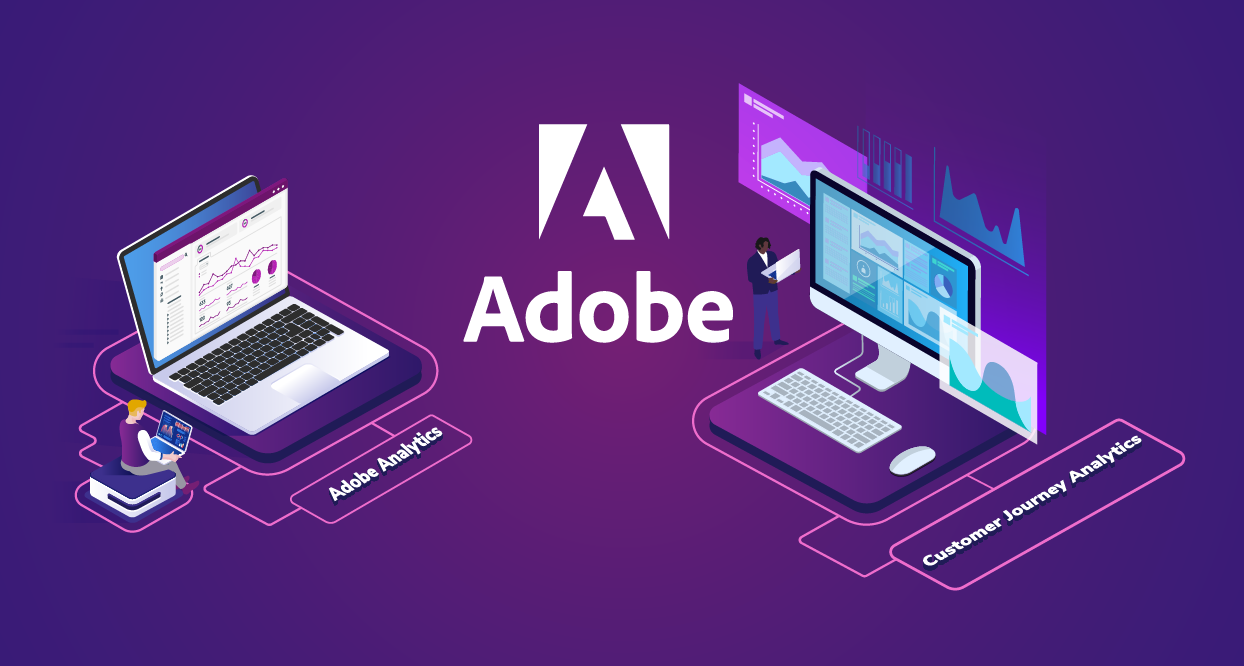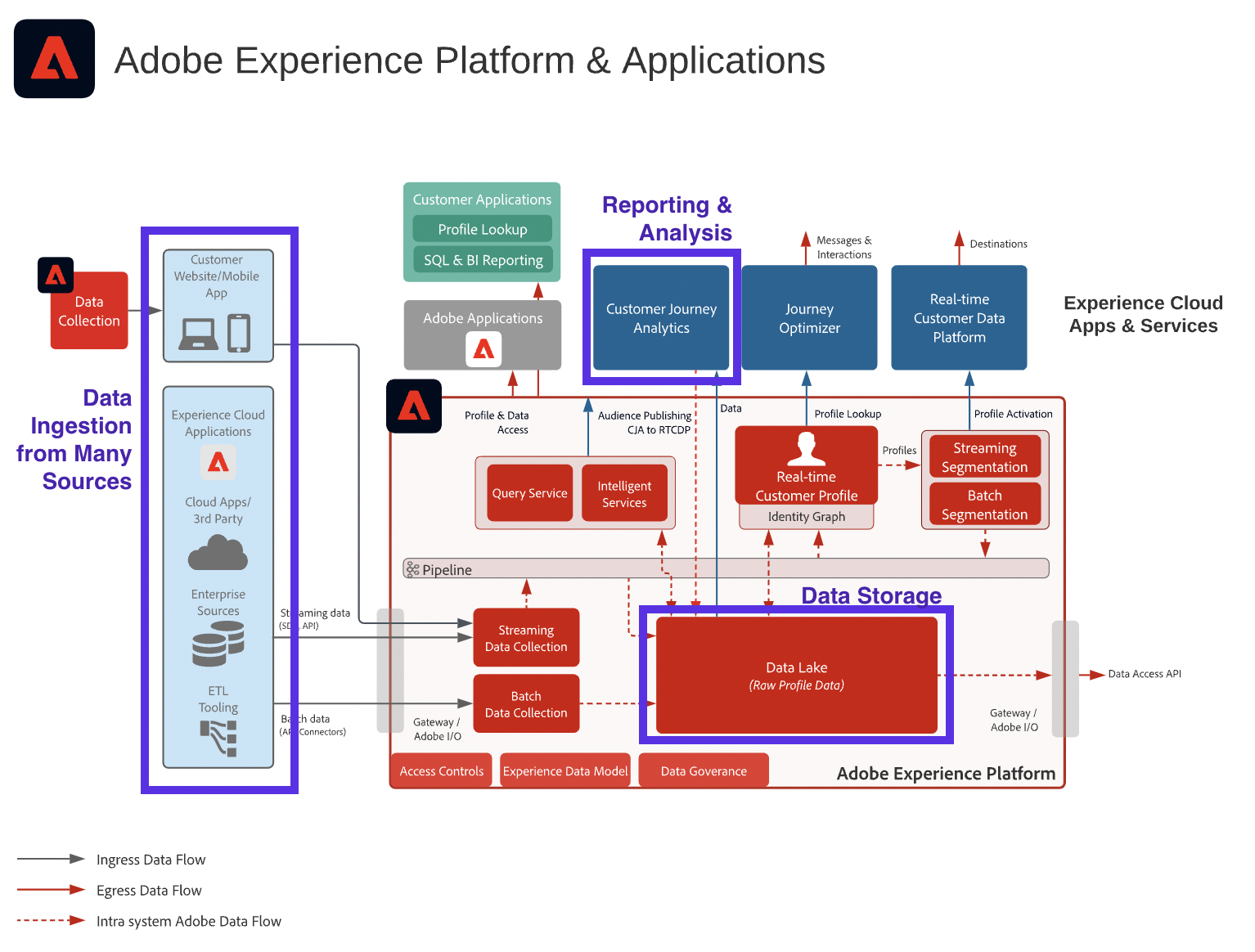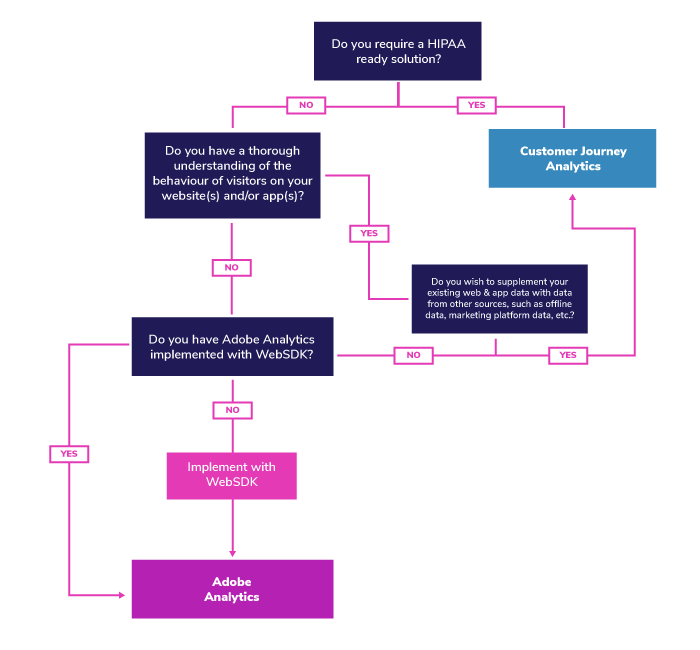Customer Journey Analytics vs. Adobe Analytics

If you’ve ended up on this page, you’ve likely expressed some interest in learning more about Customer Journey Analytics, or “CJA”. If you’ve been following the news from Adobe, you’ll know that Customer Journey Analytics is a hot topic— more than ever, Adobe is looking to highlight the role that CJA plays in Adobe’s emerging tech offerings.
Maybe you’re looking to stand up a web analytics platform on your site. Or, perhaps you’ve heard about, or even currently use Adobe Analytics and you're wondering how CJA will factor into your solutioning decisions. In the following sections, we’ll offer some guidance on the decision between Adobe Analytics and Customer Journey Analytics and how one or both platforms can suit your business’s needs.
CJA and AA Fundamentals
Before we answer the larger question about which solution is right for you, let's cover some basics of the two tools.
Adobe Analytics is Adobe’s long-standing web and app analytics platform offering in the Adobe Experience Platform set of tools. Without getting too much into the history of Adobe Analytics as it is today, AA has evolved over time into a sophisticated platform for web and app tracking, reporting and analysis.
Adobe Analytics, colloquially known as “AA”, functions as a data collection library, data storage, as well as a flexible reporting interface for reporting on web and app trends. Adobe Analytics is commonly adopted as an alternative to Google Analytics, and offers integrations with other tools in the Adobe repertoire such as Adobe Target and Adobe Audience Manager.
Customer Journey Analytics, or “CJA'', is differentiated from Adobe Analytics in its ability to incorporate data sets outside of web and app data. CJA can incorporate any persona and behavioral data sets from the Adobe Experience Platform data lake, and functions as a reporting tool for analysis of these datasets. In fact, if you’ve used Adobe Analytics’ reporting and analysis feature: Analysis Workspace, you’ll notice that Customer Journey Analytics looks suspiciously familiar.
To understand this key differentiation requires some knowledge of the larger Adobe Experience Platform architecture. Referencing the diagram below, we can see that unlike Adobe Analytics, CJA is not a self-contained solution and is instead a smaller component of a more complex stack. This includes data ingested from a number of potential sources such as CRM systems, marketing platforms, offline data sources (and yes - even web and app data!) into the AEP data-lake for storage.
To sum it up, rather than being a tool specifically for “web analytics”, CJA is essentially the reporting-layer for any and all data stored in the Adobe Experience Platform.

How Can I Use Customer Journey Analytics?
CJA’s power lies outside the narrow (though important!) realm of web analytics. As we emphasized earlier, CJA is the reporting layer for any and all data stored in the AEP data lake. CJA uses the power and flexibility of Analysis Workspace without the limitations of Adobe Analytics and only web and app data.
This means that CJA can be used with AEP to pull in any Adobe solution data, customer 1st-party data, or any other Platform data. This could include data from point of sale systems, CRM platforms as well as website and app data. Datasets can then be joined and manipulated to give your organization a fuller picture of cross-device and cross-channel journeys.
With CJA, you have the ability to perform analysis using an unlimited amount of variables, events and unique values across a wide variety of data sources. These data sources are not restricted to hit-level data schemas — you have full control over the creation and management of custom data schemas to suit your analysis needs.
In addition to data analysis capabilities, CJA can also be paired with other Adobe offerings such as Real-Time Customer Data Platform (RTCDP) to execute more advanced use cases with custom-created audiences. Unlike Adobe Analytics, CJA can also make use of personally-identifiable information, and is one of Adobe’s HIPAA ready products.
Here are some illustrative examples of when you’d use CJA:
- You’re a B2B company that wants to understand the web activity of your qualified leads
- You’re a retailer with both online and offline presence who wants to attribute omni-channel CLTV to web campaigns.
- You’re a healthcare provider that wants to connect online activity with point-of-sale data from your pharmacies
- You’re looking to invest in a future-proof technology stack, driven by first party customer data.
Can I Use CJA as a Web Analytics Reporting Platform?
This is a pivotal consideration when deciding between Adobe Analytics and Customer Journey Analytics. You’ll notice that we emphasized above that in addition to being able to utilize data from a variety of sources, web and app data can also be used with Customer Journey Analytics reporting.
There’s a few different options for utilizing web and app analytics data in CJA. If you’re an existing Adobe Analytics user and you’ve purchased CJA, the Analytics Source Connector can be used without migrating your current web data collection methods. This method has the advantage of leveraging existing data processing for features such as marketing channels and other processing rules.
If you’re setting up a new implementation, you can use the AEP WebSDK javascript library to ingest data into the AEP data lake to be used in CJA.
Technically, this means that with the proper data collection in place, CJA can be used as a web analytics reporting platform. However, the age-old wisdom applies: just because you can, doesn’t mean that you should! Adobe Analytics has always existed as a web analytics technology, and consequently features and functionalities that we expect with any web analytics application are intuitive and integral to the tool.
Customer Journey Analytics was not built to only be a web analytics tool, and feature support varies across the many Adobe Analytics functionalities we know and love depending on the implementation method. You can find the complete summary of supported features in Adobe’s documentation, but some key considerations include:
- Marketing Channel support is not 1:1 with Adobe Analytics, and some rules may be unsupported with the existing data connector
- WebSDK implementations do not currently support marketing channel processing rules, but plug-ins are available for use
- Activity Map support is not planned
- General Bot filtering is not supported if using WebSDK
- Support varies across OOTB fields powered by Device Lookup (ex: Device, Browser) or Geographical lookups (Ex: City) if using WebSDK
So, CJA or AA?
So, all of this information begs the question: “Which tool is right for my organization: Adobe Analytics or Customer Journey Analytics?”. Unfortunately, the answer is not as clear-cut as the question, and may not even be as binary as one or the other.
Ultimately, Adobe Analytics and Customer Journey Analytics in their current state serve different, although complementary functions. The emphasis here lies heavily on “in their current state” for a reason. There’s no question that Adobe plans on all customers eventually migrating to Customer Journey Analytics— you’ll even find some preparation guidelines in their official documentation.
Through our understanding of the two tools, we’re going to give some general guidance below:
You’re looking for a top-of-the-line web analytics platform to better understand the behavior of visitors to your site and/or app
Adobe Analytics remains the top-of-the-line web analytics platform that it always has been. At this current point in time, AA is the clear choice when looking solely for a web-analytics solution.
If you’re concerned about future-proofing your stack or future migration to CJA, consider implementing with CJA-supported WebSDK data collection, which is Adobe’s recommended way to implement Adobe Analytics for new customers.
You’re looking to derive cross-channel and cross-device insights across different data sources
This is what CJA is built for! If your organization has graduated to more advanced data analysis beyond analyzing web trends, customer journey analytics can unlock new and exciting insight into your customers.
Adobe will continue to bridge the gap between Adobe Analytics and Customer Journey Analytics, and it’s important to stay informed on any updates to supported features, as well as guidelines on the evolution from Adobe Analytics to Customer Journey Analytics.
To simplify the decision making process between the two tools, we’ve included the following flow chart.



